
Catalan is a Western Romance language. It is the official language of Andorra, and an official language of three autonomous communities in eastern Spain: Catalonia, the Balearic Islands and the Valencian Community, where it is called Valencian. It has semi-official status in the Italian comune of Alghero, and it is spoken in the Pyrénées-Orientales department of France and in two further areas in eastern Spain: the eastern strip of Aragon and the Carche area in the Region of Murcia. The Catalan-speaking territories are often called the Països Catalans or "Catalan Countries".
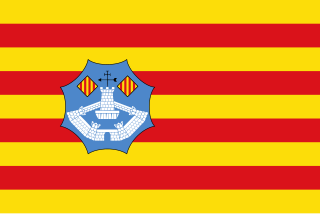
Menorca or Minorca is one of the Balearic Islands located in the Mediterranean Sea belonging to Spain. Its name derives from its size, contrasting it with nearby Mallorca. Its capital is Mahón, situated on the island's eastern end, although Menorca is not a province and forms a political union with the other islands in the archipelago. Ciutadella and Mahón are the main ports and largest towns. The port of Mahón is the second biggest natural port in the world.

Mahón, officially Maó, and also written as Mahon or Port Mahon in English, is the capital and second largest city of Menorca. The city is located on the eastern coast of the island, which is part of the archipelago and autonomous community of the Balearic Islands.

Balearic is the group of dialects of Catalan spoken in the Balearic Islands: mallorquí in Mallorca, eivissenc in Ibiza and menorquí in Menorca.
In phonetics, vowel reduction is any of various changes in the acoustic quality of vowels as a result of changes in stress, sonority, duration, loudness, articulation, or position in the word, and which are perceived as "weakening". It most often makes the vowels shorter as well.

Balearic cuisine is a Mediterranean cuisine as cooked in the Balearic Islands, Spain. It can be regarded as part of a wider Catalan cuisine, since it shares many dishes and ingredients with Catalonia and the Valencian Community. Others view it as part of a more global Spanish cuisine. Traditional Balearic cuisine is rich in vegetables, cereal and legumes as well as being low in fats. A succinct selection of the primary dishes would be ensaimades, seafood and vegetable stews, sobrassada, coques, tombet, Maó cheese and wine.

Ciutadella de Menorca or simply Ciutadella is a town and a municipality in the western end of Menorca, one of the Balearic Islands (Spain). It is one of the two primary cities in the island, along with Maó.

Sant Lluís is a municipality on the tip of south-east Menorca in the Spanish Balearic Islands.

The Balearic Islands are an archipelago in the western Mediterranean Sea, near the eastern coast of the Iberian Peninsula. The archipelago forms a province and autonomous community of Spain, with Palma de Mallorca being its capital and largest city.
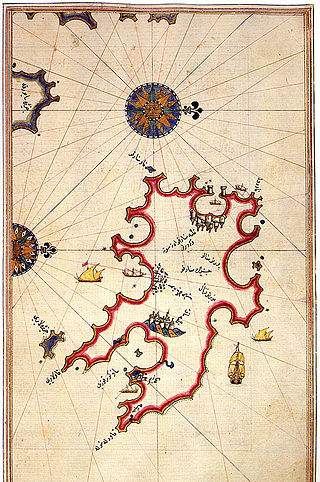
An Ottoman raid of the Balearic islands was accomplished by the Ottoman Empire in 1558, against the Spanish Habsburg territory of the Balearic islands.

The Talaiotic culture or Talaiotic period is the name used to describe the society that existed on the Gymnesian Islands during the Iron Age. Its origins date from the end of the second millennium BC, when the inaccurately named Pre-Talaiotic Culture underwent a crisis and evolved into the Talaiotic Culture. Its name is derived from the talaiots, which are the most abundant and emblematic structures from the prehistoric period of the Balearic Islands.

Doma menorquina is the traditional style of riding of the island of Menorca. It is closely associated with the Menorquín horse.

Juan Ramis y Ramis was a lawyer, writer and historian from Menorca, Balearic Islands.

The Catalan dialects feature a relative uniformity, especially when compared to other Romance languages; both in terms of vocabulary, semantics, syntax, morphology, and phonology. Mutual intelligibility between its dialects is very high, estimates ranging from 90% to 95%. The only exception is the isolated idiosyncratic Alguerese dialect.

The Cap d'Artrutx Lighthouse or Artrutx Lighthouse is an active 19th century lighthouse located on the low-lying headland of the same name on the Spanish island of Menorca. It was completed in 1859 but the tower was significantly increased in height in 1969. Automated in 1980, the keeper's accommodation is now used as a restaurant.
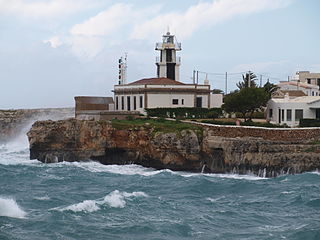
The Ciutadella, Punta de Sa Farola or Sa Farola Lighthouse is an active 19th century lighthouse on the Spanish island of Menorca. Originally completed in 1863, the tower has subsequently undergone a number of modifications. It lies close to the seaward entrance of the port of Ciutadella on the Sa Farola point, at the western end of the island. On the opposite headland is the Castell de Sant Nicolau, a 17th-century defensive tower.

Més per Menorca is a Menorcan political party. It was initially a coalition formed by the Socialist Party of Menorca, the Republican Left of the Balearic Islands, The Greens of Menorca, Equo, local parties and independents around the island until 2017. Més per Menorca was created in July 2014. Until May 2017, it had been linked to the similarly-named alliance in Majorca.

The settlement of Cala Morell is a Menorcan pre-talayotic archaeological site which is located in Ciutadella de Menorca. It is situated on a 35-meter-high coastal headland which closes the northeast side of Cala Morell's bay. This promontory is protected by a dry-stone wall, which is found in the area where the promontory connects to solid ground. It shares many features with another site which is located some kilometers away from it: Es Castellet des Pop Mosquer.
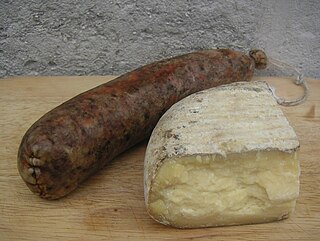
Menorcan cuisine refers to the typical food and drink of Menorca.
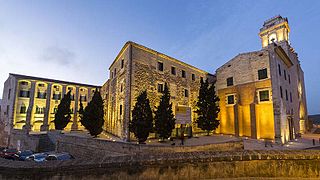
Museo de Menorca is a public institution located in the city of Mahón, Balearic Islands, Spain, which is devoted to the research and diffusion of the prehistory and history of Menorca.




















